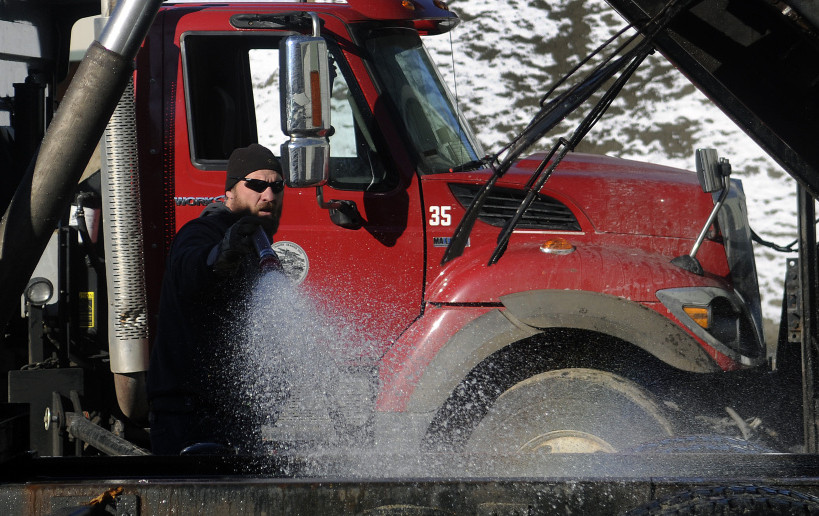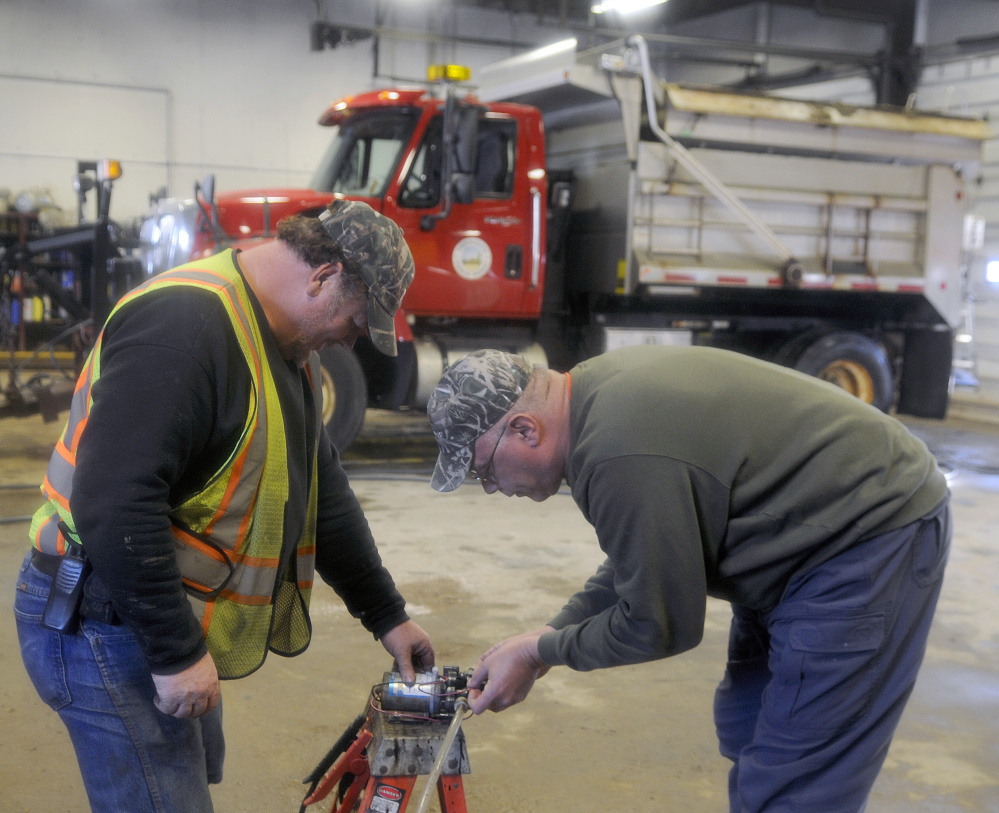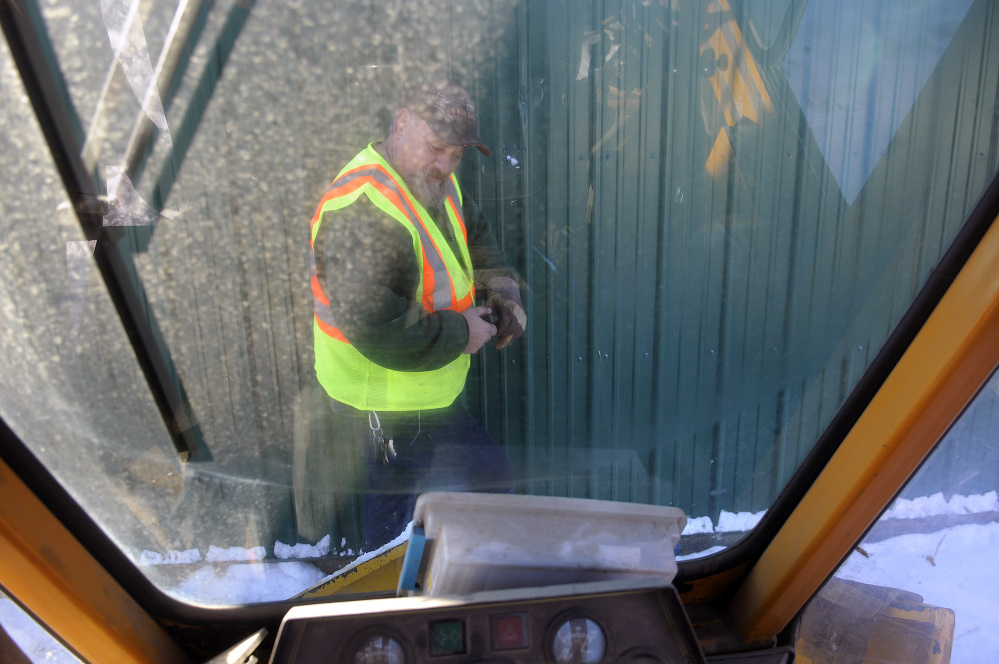A mild first snowstorm of the season Monday gave public works officials around the region a chance to work out the kinks in their departments as they prepare for a long winter ahead, municipal officials said Tuesday.
Several reported mechanical problems with pieces of equipment, including plow trucks, but the problems were expected.
Kennebec County got about 2 inches of snow Monday, and Gardiner Public Works Director Tony LaPlante said he was ready despite having three plow trucks break down.
“Luckily for us, it was a small storm and the mechanical issues were manageable,” LaPlante said. “It’s good to get the kinks out early with a smaller storm.”
Public works directors have dealt with extremes the last two winters. Two years ago, ice and snow storms pushed into March and stretched the budgets of public works departments beyond their limits. Last year, it was a record-setting winter for its warmer temperature.
LaPlante said he thinks it’s best to plan for it to be an average winter, because that way a department isn’t too short of or overstocked with supplies. He said Gardiner used about 99.9 percent of its sand and salt two years ago, but last year it used under 50 percent, so the city is in good shape for this winter.
“We’ve been budgeting the same amount of money for salt and sand every year, and some years you need more, but some years you use less,” LaPlante said. “I try and pay attention by looking at the 10-day and long-range forecasts, and we shoot for the midrange.”
Thomas Hawley, a meteorologist from the National Weather Service in Gray, said the winter forecast is indicating warmer-than-normal weather but an equal chance of above- or below-normal precipitation.
“But I can almost guarantee that it’ll be colder than last year,” Hawley said. “The chances of having record warm winters back-to-back like that are slim, so I’m guessing we’ll be closer to normal than we have the last few years.”
In Augusta and Hallowell, officials said that because of the unusually mild winter in 2014-2015, the cities have left over sand and salt and won’t be buying nearly as much as usual, if the cities buy any at all.
“Fortunately, we didn’t use much material last year, so I didn’t have to purchase any sand this year,” Augusta street superintendent Jerry Dostie said. “It saves us several tens of thousands of dollars.”
Dostie said everything went as expected during Monday’s snowfall. The department had a few mechanical problems that Dostie said are common at the beginning of the season and has several new employees in training.
“It was certainly not an extremely difficult storm, and it worked well to be able to train the new people rather than having the storm be a nightmare,” Dostie said.
Nate Rudy, working his first winter as Hallowell’s City Manager, said his city had mechanical problems similar to those in Gardiner and Augusta, but it wasn’t anything the city wasn’t prepared for.
“We’re just gearing up for a traditional Maine winter,” Rudy said. “We’re anticipating a little heavier salt and sand treatment of the roads this year, but I think we’re in pretty good shape.”
The city is in such good shape with leftover sand that Rudy has no plans to buy more and said the city will use money from the sand budget to buy additional tons of salt.
Waterville Public Works Director Mark Turner said he had crews out until about 9:30 p.m. Monday, even though by that point the worst of the storm had passed. Turner said he had his full crew, about 20 people, back out at 4 a.m. Tuesday to clear the schoolyards and clean up the downtown area. By 8 a.m., Turner said, everything was clear.
“Yesterday’s event was a good tune-up for our equipment and our manpower resources,” Turner said Tuesday afternoon. “We’re all set to go for the rest of the winter, and hopefully we won’t encounter too many situations that are difficult to handle in terms of winter storms.”
Turner said Waterville Public Works typically operates on a budget of about $1.5 million, which he said doesn’t change much from year to year. The department budgets for 18 to 20 storms a season, both major and minor storms, which he said take the same amount of effort to control — “a 2-inch storm is the same as a 10-inch storm” — because the same amount of manpower and equipment is required.
In Skowhegan, Gregory Dore, the road commissioner for the Skowhegan Highway Department, said a three-car accident temporarily prevented his trucks from dumping sand, but otherwise things ran well during the storm.
“It’s the first storm. There’s a bit of a learning curve for people to slow down,” Dore said.
Like Waterville, Skowhegan’s department operates on a budget of roughly $1.5 million, and Dore said that doesn’t typically vary by year. He said the only thing that would really be affected in the operating budget would be capital reserve accounts for things such as paving or new equipment. But the staff has dwindled from 13 to nine, he said, which can make things harder.
“A lot of times it takes us a little longer to get around now because of the reduced crew,” he said.
Part of the Waterville budget includes sand and salt, which trucks drop on the streets to melt the snow. Turner said his department budgets for about 2,700 tons of salt and about 5,000 yards of sand. He said it typically uses about 2,500 tons of salt in a given winter, but that can vary. During last year’s mild winter, he said, public works used about 1,500 tons of salt.
“That’s based on average for a typical winter,” Turner said.
There are variables that come into winter storms, such as snow changing to sleet or freezing rain. Turner said combating that kind of precipitation can take longer than snow and require more material to clear roads and sidewalks.
“There are all kinds of variables in how we prepare, but we’re ready for pretty much any situation,” Turner said.
There were several weather-related traffic accidents yesterday, and Dostie said Augusta saw the majority of the fender-benders in the late afternoon, when the temperature was dropping and drivers were heading home from work.
“The problem is a lot of time the people drive too fast and don’t drive to the conditions,” Dostie said. “People need to slow down.”
Speed limits on Interstate 95 and 295 were 45 mph for most of Monday. The limit returned to its normal 70 mph in time for the Tuesday morning commute.
Staff writer Colin Ellis contributed to this report.
Jason Pafundi — 621-5663
Twitter: @jasonpafundiKJ
Send questions/comments to the editors.







Comments are no longer available on this story